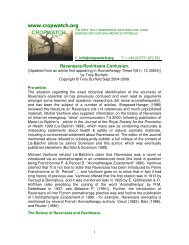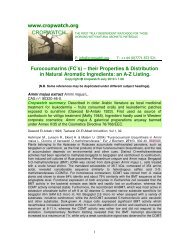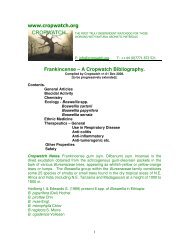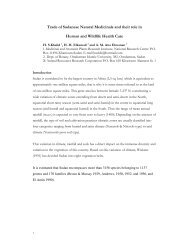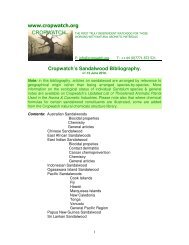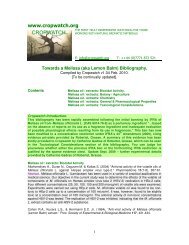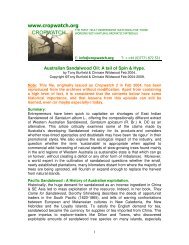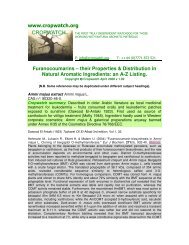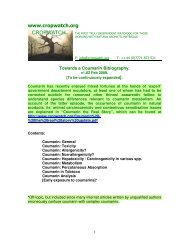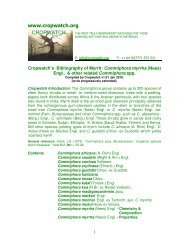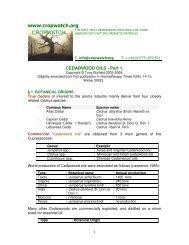The Adulteration Of Essential Oils - Cropwatch
The Adulteration Of Essential Oils - Cropwatch
The Adulteration Of Essential Oils - Cropwatch
You also want an ePaper? Increase the reach of your titles
YUMPU automatically turns print PDFs into web optimized ePapers that Google loves.
www.cropwatch.org<br />
THE FIRST TRULY INDEPENDENT WATCHDOG FOR THOSE<br />
WORKING WITH NATURAL AROMATIC MATERIALS<br />
E: info@cropwatch.org T: ++44 (0)7771 872 521<br />
<strong>The</strong> <strong>Adulteration</strong> of <strong>Essential</strong> <strong>Oils</strong> - and the Consequences to<br />
Aromatherapy & Natural Perfumery Practice.<br />
Copyright © Tony Burfield 2003-2008.<br />
[Slightly updated from the original articles featured across 3 issues of the<br />
Aromatherapy Times, 2003-2004.]<br />
Part 1. Oil <strong>Adulteration</strong>.<br />
Introduction.<br />
As far as adulteration is concerned, producers and distributors of essential<br />
oils are frequently painted as “the bad guys”, but it should be pointed out that<br />
their essential oil customers frequently demand oils below the market price<br />
while still wanting to be told that they are authentic. In this climate, the honest<br />
oil trader may find it virtually impossible to survive on the margins he is<br />
allowed to make (over the last several decades many traders have gone<br />
bust). For example, in the late 20 th Century, lavender oil (Lavandula<br />
angustifolia) was being sold almost as a loss leader by many French<br />
producers, as the market was unwilling to pay a realistic price. Currently, the<br />
aroma industry is dominated by a handful of large and powerful international<br />
houses whose corporate buyers often attempt to drive raw material prices to<br />
impossibly low levels, not allowing workable profits to be made. This very fact<br />
sets the scene for unethical practices.<br />
<strong>Essential</strong> oils - a definition.<br />
An essential oil (e.o.) is the volatile oil containing odiferous elements of the<br />
plant, produced by steam or hydro-distillation of aromatic vegetable plant<br />
matter. E.o. components arise via the secondary metabolism of plants and are<br />
stored within specialised structures; ideally they are isolated with a minimum<br />
number of chemical changes from human intervention. Citrus oils, produced<br />
by the mechanical pressing of citrus peels, are also called essential oils, and,<br />
according to the International Standards Organisation (ISO), so are drydistilled<br />
oils - such as cade oil (from the branches of Juniperus oxycedrus)<br />
and styrax pyrogenée (from Liquidamber spp).<br />
E.o.’s should be produced by purely physical means, should be completely<br />
pure and 100% wholly derived from the named botanical source - but how are<br />
these standards to be guaranteed? No quality standards for the authentication<br />
of essential oils exist in aromatherapy, in spite of the revelations of gross<br />
1
adulteration of aromatherapy oils for retail sale (Health Which 2000).<br />
Professional aromatherapy organisations have failed to issue standards, in<br />
spite of individual schemes being put forward (Jones 1998) but, in contrast,<br />
other essential oil-using industries are served by the following standards:<br />
<strong>The</strong> Pharmaceutical Trade: British Pharmacopoeia (BP) – the latest issued of which is the<br />
BP 2007 - is published on the recommendation of the Medicines Commission UK. <strong>Essential</strong><br />
oil specifications are also published in the European Pharmacopoeia 5 th edn ; United States<br />
Pharmacopoeia (USP); also the pharmacopoeia’s of individual nations such as China, India<br />
etc. Earlier editions of <strong>The</strong> British Pharmaceutical Codex (BPC) contains many essential oil<br />
standards. still in use today.<br />
<strong>Essential</strong> Oil Trade: Monographs on individual essential oils (EOA Standards) were<br />
produced by the Scientific Committee of the <strong>Essential</strong> Oil Association Inc.<br />
Flavourings Industry: Food Chemicals Codex (the latest is FCC V) is produced at the<br />
request of the FDA (1992), is widely used for guidance by the food flavourings industry.<br />
Aroma Companies: Many larger established Flavour & Fragrance Houses have their own<br />
internal purchasing standards.<br />
Independent Certifying Bodies: International Standards Organisation (ISO Standards TC<br />
54) & Association Française de Normalisation (AFNOR) both have detailed standards for<br />
individual e.o.’s.*<br />
*An example is ISO 3515 for Oil of Lavender (2001) which includes minimum and maximum<br />
percentages of thirteen substances, and their occurrence in French (spontaneous and clonal),<br />
Bulgarian, Russian, Australian and ‘other origin’ lavender oils. Limits for lavandulyl acetate,<br />
for example, are set at 2.0-5.0% in Bulgarian lavender oil by the standard.<br />
Aromatherapy<br />
Whilst it is apparent that the current BP or ISO standards may serve the<br />
needs of particular industrial sectors, they do not entirely address the unique<br />
needs of the aromatherapy profession, since:<br />
• Holistic aromatherapists demand that “pure” and “complete” oils are<br />
used, rather than oils only distilled for periods which are attractive<br />
economically, on a yield: fuel-consumption basis. Additionally, herbal<br />
essential oils with typically quick distillation times may have lower<br />
carbon-footprints that wood oils which require several days of<br />
distillation e.g. from endangered sandalwood & agarwood species.<br />
• Many essential oils used in aromatherapy are particular to that<br />
profession, and not necessarily extensively used elsewhere e.g. oils of<br />
Ravensara aromatica, Rosemary oil verbenone chemotype,<br />
Helichrysum italicum ssp. serotinum etc.<br />
As well as “pure and natural”, the words “wild-crafted”, “organic” and<br />
“therapeutic grade” are frequently over-hyped descriptor terms used by both<br />
aromatherapy and by “naturals” traders, which need more careful definition<br />
prior to professional endorsement.<br />
Natural perfumery<br />
Natural perfumers are other potential users of pure essential oils. Grimshaw<br />
(1989) discussed “purist” perfumers (who employ no chemically produced or<br />
chemically modified ingredients), but also discussed reasons why others may<br />
wish to use up to 50% synthetics in formulations. This was, in a way, a<br />
2
prediction today’s situation, whereby aromachology perfumes (which<br />
enjoyed sales of £611 million for years 1999-2001 according to Mintel<br />
Database 2002) contain a proportion of synthetics stipulated by the perfume<br />
house, mixed in with the e.o.’s. <strong>The</strong> alleged psychopharmaceutical effects of<br />
these products still depend on the utilization of authentic essential oils in the<br />
formulation – as far as marketing claims/hype are concerned anyway. A<br />
realistic “in-practice” distinction between mass-marketed aromatherapy<br />
perfumes (as opposed to 100% e.o. blends) and aromachology perfumes,<br />
other than at a hypothetical level, has yet to be defined, since both commonly<br />
employ synthetics. <strong>The</strong> synthetics content can presumably have either<br />
symbiotic, neutral or opposing effects (mood changing etc.) to those claimed<br />
for the e.o.’s in the perfumes in question, hence the need for clinical testing of<br />
the finished formulations to support advertising claims.<br />
Types of adulteration.<br />
<strong>The</strong>re are several distinct categories of adulteration:<br />
1. Addition of single raw materials. This simple form of adulteration can be<br />
conveniently divided into two groups:<br />
• “Invisibles” – i.e. those materials undetectable by a gas chromatograph<br />
(GC) analysis operating under routine set conditions ermployed to<br />
analyse essential oils.<br />
• “Visibles – those materials which are normally detectable by GC.<br />
“Invisibles”: an example of this type is the deliberate addition of vegetable or<br />
mineral oil to essential oils (Nour-el-Din et al. 1977) - rapeseed oil in the EU is<br />
a particularly cheap vegetable oil which has been used for this purpose,<br />
whereas you might be unfortunate enough encounter palm oil in S.E. Asian<br />
products i.e. patchouli or vetiver oils. <strong>The</strong>oretically the “total area” of the<br />
detectable components of the oil’s gas chromatogram should be reduced by<br />
this latter type of adulteration, creating a suspicious situation for the analyst<br />
prompting the need for further investigation. <strong>The</strong>se adulterant materials may<br />
be revealed by simple aqueous alcohol solubility tests, and their presence<br />
further verified by using a different GC column & operating conditions (to<br />
detect mineral oil), or by derivatisation (for example the use of a methylating<br />
agent to react with the vegetable oil – thereby creating volatile methyl esters<br />
of the fatty acid components of oil’s glyceryl esters, which can be revealed by<br />
subsequent GC analysis).<br />
“Visible” diluents in this context include a number of solvents and perfumery<br />
materials. It is an ‘obvious’, readily detectable & unsophisticated form of<br />
adulteration, but nevertheless the following have been found in commercial<br />
essential oils: in a few instances, resulting in a warning or prosecution by<br />
regulatory authorities:<br />
Abitol (a primary hydroabietyl alcohol) – often used for extending resinoids.<br />
Benzyl alcohol (now classified as an allergen in the EU Cosmetics Directive)<br />
Benzyl benzoate (now classified as an allergen in the EU Cosmetics Directive –<br />
formerly widely used to ‘extend’ resinoids)<br />
3
Carbitol (diethylene glycol monoethyl ether or DEGME)<br />
Diacetone alcohol<br />
Dipropylene glycol (DPG)<br />
Dipropylene glycol methyl ether (DPGME) and tripropylene glycol methyl ether<br />
(TPGME) - both of these substances are in air freshener technology.<br />
Herculyn D (hydrogenated methyl ester of rosin)<br />
Isopar (odourless kerosene fractions often used as a candle perfume diluent)<br />
Isononyl acetate<br />
Isopropyl myristate (IPM)<br />
Phthalate esters such as dibutylphthalate (DNP) or diethyl phthalate (DEP).<br />
Triacetin (the anti-fungal compound glycerol triacetate - a popular food<br />
flavourings vehicle).<br />
3,3,5-Trimethyl-hexan-1-ol.<br />
Use of other ‘visible’ materials like isotridecyl acetate (ITDA, Fixateur 404),<br />
Herculyn D and Abitol, can be more difficult to spot in practice, because the<br />
materials may show a myriad of late-eluting small peaks on a GC trace<br />
representing their different constituent isomers, which could be overlooked by<br />
an inexperienced analyst, especially at low levels.<br />
In all the above instances of “visible” and “non-visible” adulterants, the added<br />
material is merely a diluent, and makes no odour contribution of its own.<br />
Addition of 10-14% of such a material may pass un-noticed if the material is<br />
evaluated against a retained standard solely on an odour basis – even by an<br />
expert nose – but it will in all probability be revealed by subsequent physiochemical<br />
testing e.g. added vegetable oil in patchouli oil can often be revealed<br />
by a standard solubility test in 90% ethanol at 20°C.<br />
2. <strong>The</strong> addition of cheaper essential oils and adjuncts.<br />
Blending-in cheaper oils to meet a customers’ target purchasing price, or to<br />
make additional profit for the producer, is commonplace in the oil trade. Some<br />
practices mentioned by Arctander (1960) - for example, the practice of<br />
extending of Amyris oil (Amyris balsamifera) with Cedarwood oil Virginia<br />
(Juniperus virginiana) & Copaiba Balsam (Copaifera spp.) – are unlikely to<br />
fool too many potential customers in these present & more educated times,<br />
but other more common adulteration practices still remain, which include:<br />
Bergamot oil (Citrus bergamia): addition of lemon oil, rectified ho oil (Cinnamomum<br />
spp.) and acetylated ho oil.<br />
Bitter orange oil (Citrus aurantium subsp. aurantium): addition of sweet orange<br />
oil (Citrus sinensis) & orange terpenes, plus trace amounts of character<br />
compounds.<br />
Cedarwood oil Virginia (Juniperus virginiana): addition of cedarwood oil<br />
Chinese (Cupressus funebris).<br />
Cinnamon bark oil (Cinnamomum zeylanicum): addition of cinnamon leaf oil.<br />
Cinnamon leaf oil (Cinnamomum zeylanicum): addition of clove fractions,<br />
eugenol, cinnamic aldehyde etc.<br />
Clove Bud oil (Syzygium aromaticum): addition of clove stem oil & the isolates:<br />
eugenol & eugenyl acetate.<br />
Fir Needle oils (Abies spp.): addition of turpentine fractions, camphene, (-)-<br />
bornyl acetate etc.<br />
Geranium oil Chinese (Pelargonium hybrids): addition of adulterated Indian<br />
4
geranium oil (which itself has been known to contain diphenyl oxide!),<br />
Grapefruit oil (Citrus paradisi): addition of orange terpenes or sweet orange oil<br />
distilled + minor amounts of (+)-nootkatone & others.<br />
Lavender oil (Lavandula angustifolia): addition of cheaper lavandin (Lavandula<br />
x intermedia) oil varieties; the addition of spike lavender oil (Lavandula<br />
latifolia); the addition of ho oil rectified (Cinnamomum spp) and acetylated<br />
ho or acetylated lavandin oils etc.<br />
Lemon oil (Citrus limon): addition of orange terpenes, lemon terpenes & by-<br />
products (e.g. steam-stripped lemon oil). For lemon oil BP, expressed lime or<br />
grapefruit oil is added to poor grades to raise the UV absorbance level<br />
sufficiently to pass the BP specifications.<br />
Nutmeg oil (Myristica fragrans): the addition of nutmeg terpenes, α- pinene,<br />
limonene, turpentine fractions etc.<br />
Patchouli oil (Pogostemon cablin): addition of gurjun balsam (Dipterocarpus<br />
spp.); vegetable oils, Hercolyn D; patchouli and vetiver distillation residues.<br />
<strong>The</strong> superior Indonesian patchouli oil is sometimes blended with cheaper<br />
Chinese oil patchouli oil.<br />
Petitgrain oils (Citrus spp): addition of other citrus leaf oils & fractions, fatty<br />
aldehydes, linalyl acetate, orange terpenes etc.<br />
Peppermint oil (Mentha X piperita): addition of cornmint oil (Mentha arvensis).<br />
Sandalwood oil EI (Santalum album): addition of West African sandalwood oil<br />
(Osyris lanceolata), West Australian sandalwood extract fractions (Santalum<br />
spicatum), sandalwood terpenes & synthetic sandalwood fragrance chemicals etc.<br />
Rosemary oil (Rosmarinus officinalis) addition of eucalyptus oil Eucalyptus<br />
globulus) & especially camphor oil white (Cinnamomum camphora).<br />
Verbena oil (Lippia citriodora): L. citriodora herb distilled over lemon oil.<br />
Violet Leaf absolute (Viola odorata): addition of spinach absolute (Spinacia<br />
oleracea).<br />
Ylang Ylang oil qualities (Cananga odorata subsp. genuina): addition of<br />
cananga oil (Cananga odorata), ylang ylang oil tails etc., ylang ylang oil<br />
reconstitutions.<br />
And also addition of these synthetics to “convert” one oil to another:<br />
Basil oil exotic: add linalol to convert to Basil oil Sweet (Arctander 1960).<br />
Eucalyptus globulus: add α-terpineol & others to convert to Eucalyptus radiata.<br />
Geranium oil Chinese to Geranium oil Bourbon: addition of balancing<br />
materials (monoterpene alcohols and esters, especially formates), copper<br />
chlorophyll (for colour) and frequently a trace of dimethyl and/or dibutyl<br />
sulphides.<br />
Tangerine oil (Citrus reticula var. tangerine): addition of γ-terpinene, dimethyl<br />
anthranilate, α-sinesal & perilla aldehyde to ‘convert’ Tangerine to Mandarin oil<br />
(Citrus reticulata var. mandarin).<br />
3. <strong>The</strong> addition of cheap (nature identical) synthetics to oils that naturally<br />
contain these materials. Little detailed guidance has been previously<br />
published in this area. <strong>The</strong> older work of Arctander (1960) mentions a<br />
number of adulteration practices, but the sophistication of customer quality<br />
control procedures probably means that of the noted practices are now too<br />
obvious for today’s market. Looking at other published material on<br />
adulteration, Singhal et al. (2001) remark on the adulteration of spice oils by<br />
simple additions of single raw materials e.g. the addition of synthetic citral to<br />
5
Litsea cubeba oil. My own guide to questionable practices include the<br />
following:<br />
Anise oil (Pimpinella spp.): addition of technical grade anethol.<br />
Basil oil exotic (Ocimum spp.): addition of methyl chavicol & linalol.<br />
Benzoin resinoid (Styrax spp.): addition of small amounts of vanillin, benzyl<br />
benzoate, ethyl & benzyl cinnamates, benzoic acid etc. to enhance odour (or<br />
to pass off cheaper “Sumatra” benzoin grades as “Siam”).<br />
Bergamot oil (Citrus bergamia): addition of linalol and linalyl acetate.<br />
Bitter almond oil (Prunus amygdalus var. dulcis ): addition of, or passing off<br />
Benzaldehyde plus a few minor character compounds, as the oil.<br />
Buchu leaf oil (Barosma betulina & B. crenulata): addition to cutters of<br />
monoterpene sulphide fractions synthesised from the hydrogen sulphide<br />
treatment of pulegone, including p-menthan-8- thiol-3-one.<br />
Cassia oil (Cinnamomum aromaticum): the addition of synthetic cinnamic<br />
aldehyde, methyl cinnamic aldehyde & coumarin.<br />
Chamomile oil Roman (Anthemis nobilis): addition of isobutyl angelate and<br />
synthetic bisabolols.<br />
Cinnamon bark oil (Cinnamomum zeylanicum): the addition of synthetic<br />
benzaldehde, eugenol and cinnamic aldehyde.<br />
Citrus oils: the addition of formulations of fatty aldehydes, monoterpene alcohols &<br />
monoterpene esters to terpeneless and folded citrus oils.<br />
Caraway seed oil (Carum carvii): the addition of limonene and (+)-carvone<br />
Cardamom oil (Elletaria cardamomum): addition of linalyl acetate, 1,8-cineole and<br />
α-terpinyl acetate.<br />
Celery seed oil (Petroselenium crispum): the addition of limonene + touches of<br />
alkyl phthalides.<br />
Cognac oil: addition of ethyl esters of aliphatic acids e.g. ethyl oenanthate.<br />
Coriander seed oil (Coriandrum sativum): addition of linalol and trace amounts<br />
of certain pyrazines. NB price fluctuates – not always economic!<br />
Cypress oil (Cupressus sempervirens): addition of α-pinene, δ-3-carene &<br />
myrcene.<br />
Cumin seed oil (Cuminum cyminum): addition of cuminaldehyde and others.<br />
Dill seed oil (Anethum graveolens): addition of α-phellandrene & limonene.<br />
Elemi oil (Canarium luzonicum): addition of α-phellandrene & limonene.<br />
Galbanum resinoid (Ferula galbaniflua): addition of β-pinene, undecatrienes and<br />
others.<br />
Garlic oil (Allium sativa): addition of aliphatic sulphide mixtures containing<br />
2-propenyl disulphide, 1-propenyl disulphide etc.<br />
Geranium oils (Pelargonium hybrids): the addition of laevo-citronellol & geraniol<br />
Jasmine absolute (Jasmimum spp): reconstructions frequently added.<br />
Juniper oil (Juniperus communis var. erecta): addition of terpene<br />
hydrocarbon mixtures containing α-pinene & δ-3-carene, also Juniper branch<br />
oil and second grade oils from spoiled Juniper berries.<br />
Labdanum resinoid (Cistus landiferus): formerly, the addition of DEP (now<br />
discontinued) or Abitol, with small amounts of ambroxan and p-methyl<br />
acetophenone to enhance odour.<br />
Lavender oil, spike (Lavandula latifolia): addition of eucalyptus & white<br />
camphor oil fractions, spanish sage oil etc.<br />
Lemongrass oil (Cympogon spp.): addition of synthetic citral.<br />
Litsea cubeba oil: the addition of synthetic citral.<br />
Mentha citrata oil: addition of linalol + linalyl acetate.<br />
Mustard oil (Brassica nigra & B. juncea): allyl isothiocyanate is passed off as the<br />
oil (which is used in flavourings, but is banned in perfumery & aromatherapy).<br />
6
Neroli oil (Citrus aurantium subsp. aurantium): reconstructions frequently<br />
added to, or passed off, as the authentic oil.<br />
Origanum oil (Origanum spp.): addition of para-cymene and carvacrol.<br />
Onion oil (Allium cepa): addition of synthetic aliphatic sulphide mixtures.<br />
Palmarosa oil (Cymbopogon martinii var. motia): the addition of geraniol.<br />
Petitgrain oil Paraguay (Citrus aurantia subsp. aurantium ): addition of<br />
admixture of linalol, linalyl acetate, α-terpineol, geranyl & neryl acetates &<br />
trace amounts of pyrazines etc.<br />
Pine needle oils (Pinus spp.): addition of (-)-bornyl acetate, isobornyl acetate, (-)-<br />
limonene, α-pinene, camphene etc.<br />
Rose oil (Rosa spp.): reconstructions using damascones, β-ionone plus<br />
(-)-citronellol and other rose alcohols, plus rose steroptenes. Occasionally<br />
adulterated with β-phenylethyl alcohol, rhodinol fractions and cheaper rose oils<br />
(Morocco, Crimea etc.).<br />
Rosemary oil (Rosmarinus officialis): addition of camphor, isobornyl acetate (+<br />
Eucalyptus & turpentine oil fractions).<br />
Rosewood oil (Aniba spp): addition of linalol, plus trace amounts of methyl<br />
heptenone, methyl heptenol, 3-octanol, para-methyl acetophenone etc.<br />
Spearmint oil (Mentha spicata): addition of (-)-carvone.<br />
Thyme oil (Thymus spp.): addition of para-cymene & thymol. “Red thyme oil” is<br />
often a wholly synthetic construct.<br />
Vetiver oil acetylated (Vetivera spp): the addition of cedrenyl acetate.<br />
Wintergreen oil (Gaultheria procumbens): the adding of, or passing off of synthetic<br />
methyl salicylate, as the oil.<br />
Ylang ylang oil (Cananga odorata var. genuina): addition of benzyl acetate,<br />
methyl benzoate, para-cresyl methyl ether, geranyl acetate, benzyl benzoate,<br />
benzyl cinnamate, cedarwood oil and others or complete reconstitutions/bases.<br />
Boelens (1997) described four types of odourants in essential oils: character<br />
compounds, essential compounds, balance compounds and artifacts.<br />
Adulterants such as monoterpene hydrocarbons, being balance compounds in<br />
Boelens scheme above, do little for the characteristic odour of the cut oils,<br />
since the added materials have little odour value in themselves. In practice,<br />
the addition of certain adulterants “flattens” the odour profile of the authentic<br />
oil, or otherwise dilutes or represses some true character, sparkle and<br />
richness. To compensate for this, a practiced oil counterfeiter will add small<br />
amounts of character compounds. Taking the example of Cypress oil<br />
Cupressus sempervirens var. stricta, the oil is often adulterated by the<br />
addition of the monoterpene hydrocarbons α-pinene and δ-3-carene, which<br />
creates a crude terpinic aspect. <strong>The</strong> addition of a small amount of deca-2-<br />
(E),4-(Z)-dienyl isovalerate to the somewhat insipid cutting agent, will give a<br />
better impression of the oil’s normal character, a lead which follows on from<br />
the work of Garnero et al. (1978) who identified the compound above in<br />
cypress shoots, and found it strongly reminiscent of the typical odour of<br />
cypress oil.<br />
Commercial oils, adulterated by such synthetics, can often fool the less<br />
sophisticated nose, or satisfy those oil customers buying to a price, where<br />
authenticity is sometimes not a primary consideration. Depending on exact<br />
market conditions, some oils have a selling price which is so cheap that it is<br />
generally unrewarding for a trader to reconstitute, or even add, nature<br />
7
identical aroma chemicals, to the product, except for some solvent-like<br />
diluents. This category would include the following oils:<br />
Sweet orange oil (Citrus sinensis)<br />
Clove leaf oil & stem oils (Syzygium aromaticum)<br />
Citronella oil (Cymbopogon spp.): (although the oil has been known to have been<br />
crudely adulterated with dipentine and citronella terpenes)<br />
Camphor oil white (Cinnamomum camphora fractions)<br />
Cornmint oil (Mentha arvensis subspp).<br />
Eucalyptus globulus oil<br />
Tea tree oil (Melaleuca altenaria) (although through the economies of larger scale,<br />
it may be profitable to add terpinen-4-ol and α- & γ-terpinenes; up until recently they<br />
have been been as expensive as the essential oil).<br />
Other oils may be difficult to reconstitute with anything other than diluents<br />
because the major components are not commercially available; as is the case<br />
with patchouli oil & vetiver oils. .<br />
4. <strong>The</strong> addition of isolates or natural components to essential oils e.g.<br />
the addition of pure natural eucalyptol ex E. globulus oil (Eucalyptus globulus)<br />
to rosemary oil (Rosmarinus officinalis) or rectified ho oil (>99.5% (-)-linalol) to<br />
lavender and bergamot.<br />
5. <strong>The</strong> addition of bases or reconstituted essential oils to genuine oils &<br />
absolutes. It is particularly economically attractive to extend high value floral<br />
absolutes such as rose (Rosa spp.), jasmin (Jasminum grandiflora other spp.)<br />
and osmanthus (Osmanthus fragrans var. auranticus), and the more valuable<br />
oils such as neroli oil and rose otto, and this practice occurs extensively within<br />
the trade.<br />
6. <strong>The</strong> addition of individual unnatural components to oils and aromatic<br />
raw materials.<br />
Absolutes have been traditionally produced for the consumption of the<br />
perfumery industry, but are being increasingly employed in aromatherapy (in<br />
spite of using un-natural solvents in their manufacture). Revelations that<br />
materials such as Linden Blossom absolute (Tilia spp.) contain<br />
hydroxycitronellal, or that Gardenia absolute (Gardenia spp.) has added<br />
styrallyl acetate, or that added Schiff’s bases have been found in floral<br />
absolutes, should not therefore come as a complete surprise. It has been<br />
suggested that if the synthetic fragrance compound is added in to the<br />
aromatic plant material during manufacture, the added material will “blend in”<br />
better. In other instances, absolutes may well contain perfume bases or<br />
reconstitutions, rather than a single key character compound.<br />
7. <strong>The</strong> addition of ”normal” oils to oils certified as “organic”.<br />
Many certifying bodies (EcoCert, Soil Association) seemingly rely on<br />
inspection regimes, batch tracking and the separate & secure storage of<br />
organic oils, rather than independently analysing finished oils for pesticide<br />
levels, a situation inviting abuse by unscrupulous traders. <strong>The</strong>re is also the<br />
huge question of “who inspects the inspectors”, the lack of external expert<br />
input into their protocols, and the denial of free public access to the records of<br />
these bodies – but these topics (and many others) are another issue! <strong>The</strong><br />
8
labelling laws seem so lax in the EU, that an advertising claim on a bottle,<br />
such as “contains organic orange oil” would not invite prosecution if the oil<br />
contained 0.1% organic orange oil and 99.9% non-organically produced<br />
orange oil – and who, specifically, is charged with checking anyway, and who<br />
has the necessary expertise? Further, it has been revealed that on more than<br />
one occasion, oils from endangered species have been about to be certified<br />
as “organic” by one particular organisation with seemingly little ecoawareness,<br />
and with little experience of complexities of the oil trade<br />
(Wildwood 2002), to which the president of the association concerned is<br />
reported to have replied that certification is “…bound to be an evolving<br />
process, very often in uncharted territory”. And so many of us “at the coalface”<br />
feel that the whole organic oils exercise, although possibly very noble in<br />
its intent, is not particularly watertight.<br />
8. Passing off one essential oil as another.<br />
“Old chestnuts” in this category include the following deceptions:<br />
Cinnamomum camphora (var. cineole type) fractions (1,8-cineole rich) were<br />
passed off extensively as Eucalyptus globulus oil by certain Chinese<br />
suppliers in early 1998. Cineol rich fractions from Cinnamomum<br />
longepaniculatum may be used for the same purpose.<br />
Cornmint oil from Mentha arvensis var. piperascens as peppermint oil Mentha<br />
x piperita (however, Chinese and Brazilian “peppermint oils” do derive from<br />
M. arvensis subsp.).<br />
Melissa oil is frequently concocted from mixtures of Citronella oil, Litsea<br />
cubeba, lemon oil (Citrus limon) and various other isolates & synthetics.<br />
Micromeria fructicosa (Turkish pennyroyal) & Hedeoma pulegioides<br />
(American pennyroyal) have been passed off as pennyroyal oil (Mentha<br />
pulegium).<br />
Treemoss resinoid (Pseudoevernia furfuracea) is passed off as or use as an<br />
extender for Oakmoss resinoid (Evernia prunastri).<br />
Petitgrain oil terpeneless (Citrus aurantium subsp. aurantium) has a former<br />
tradition of being passed off as rosewood oil (Aniba spp.). Petitgrain oil<br />
Paraguay may be passed off as petitgrain bigarade.<br />
Siberian silver fir needle oil Abies siberica has been often passed off as Siberian<br />
pine oil Pinus siberica.<br />
Sweet orange oil Brazil has been passed off as the finer Sweet orange oil<br />
Florida.<br />
Star anise oil Illicium verum has been passed off as anise oil (Pimpinella spp),<br />
and synthetic anethole is passed off as star anise oil (in certain anise type<br />
liquors!).<br />
Tolu balsam (Myroxylon balsamum var. αααα-genuinum..): some aroma concerns<br />
acknowledge that the commercial products offered are not genuine<br />
(Biolandes 1997), offered products often being blends of Styrax spp. and<br />
aroma chemicals etc.<br />
…. and three additional categories which are arguably more about<br />
“contamination” than adulteration:<br />
9. Co-gathering one species with another.<br />
9
This may be deliberate or accidental, and might arise through lack of botanical<br />
education of the involved gatherers, especially those involved in “wildcrafting”.<br />
Artemisia mesaltantica (“Blue Armoise”) and A. atlantica growing in Morocco are<br />
often co-gathered or deliberately passed off as Moroccan Armoise oil (A. herbaalpa).<br />
However the situation is further complicated by the fact that there are at least<br />
four chemotypes of A. herba-alpa (!) according to Richard et al. (1984).<br />
Litsea enosma & L. mollifolia as well as other Litsea species are used to produce<br />
the oil of Litsea cubeba according to Zhaobang (1995).<br />
Massoy essential oil (from bark of Cryptocarya massoy), containing up to 90% of<br />
lactones, is used in flavourings. Joulain (1994) reports that bark has been frequently<br />
been gathered with the bark of other species in the past (which in the case of bark<br />
from Cinnamomum spp., might contain high levels of safrole, of toxicological<br />
concern).<br />
Nardostachys grandiflora is said to be often co-gathered with Valeriana wallichi<br />
according to Traffic International (1999) and that published chemical compositions of<br />
essential oils from these species are similar – see http://www.cropwatch.org<br />
10. GM-Free <strong>Essential</strong> Oil Production Methods.<br />
Many EU oil-buying customers require oils to have been produced by plants<br />
free of gene modification, or free of Genetically Modified Organisms (GMO’s)<br />
themselves, and to be free of their use, and use of their derivatives during<br />
manufacture, according to Commission Regulations 50/200, 1139/98,<br />
90/220/EEC and 2092/91/EGW Biological Agriculture. Certificates to show<br />
that plant material was polymerase chain negative may need to be provided<br />
by suppliers to prove GM-free status.<br />
11. <strong>Oils</strong> produced from non-irradiated vegetable sources.<br />
Many essential oil customers require oils certified as being manufactured from<br />
non-irradiated sources at any point of the production process, in order to<br />
comply with EU Directives 99/2/EC and 99/3/EC, and so may require<br />
statements that the original oil-source vegetable raw material, (including<br />
spices), have not been gamma-ray irradiated. Suitable sources of γ-radiation<br />
ate usually taken to be cobalt-60, caesium-137 and electron/X-ray irradiation<br />
from an electron accelerator. It is of note that certain terpene compounds are<br />
changed by irradiation – Kawashima K. (1981) found that α-terpinene, γterpinene<br />
and terpinolene levels drop at a dose of 7.5 kGy, whilst other spices<br />
such as cardamom and coriander change flavour attributes at the same dose<br />
Bachman & Gieszcznska (1973). Rapid tests are now available to establish<br />
irradiation status - cumin seeds for example can be subjected to the rapid<br />
detection method for γ-irradiation, developed by Satyendra et al. 1988.<br />
Spotting adulteration.<br />
Odour evaluation.<br />
A trained perfumer or essential oils analyst might immediately spot a QC<br />
problem with an oil sample before committing the oil to more sophisticated<br />
10
analytical tests – in fact the e.o. may simply be rejected on a poor or<br />
uncharacteristic odour profile. So, in spite of great technological<br />
advancements in analysis techniques (sometimes bordering on scientific<br />
imperialism), the trained nose can still be the single most important arbiter of<br />
quality, and it is important to keep sight of this fact.<br />
Analytical procedures.<br />
Quality control procedures for essential oils in aromatherapy have already<br />
been (briefly) discussed by Garnero (1999).<br />
Physiochemical methods.<br />
<strong>The</strong>se standard tests have long been used to help establish the identity of oil,<br />
on the basis that normally produced genuine oils have characteristic values<br />
for:<br />
Specific gravity/ Relative density<br />
Refractive index<br />
Optical Rotation<br />
Tests are normally carried out at ambient temperature (20°C or 25°C) if the<br />
oils are normally liquids at this temperature; guiaicwood oil (Bulnesia<br />
sarmienti) & rose otto (Rosa spp.) etc., are normally solid in temperate climes<br />
at ambient , and may be evaluated at 40°C.<br />
<strong>Essential</strong> oils are sometimes traded on the basis of “USP figures” or “BP<br />
figures”. This means that the oils conform the relevant specifications in spite<br />
of synthetic additions, but obviously do not conform to the “100% wholly<br />
derived from the named botanical source” requirements of the pharmacopoeia<br />
monographs.<br />
Chemical tests.<br />
[<strong>The</strong> first two tests are indicative of contamination rather than adulteration, but<br />
are included as examples of requirements in sister industries].<br />
Heavy metals – in essential oils used as food flavourings, a limit of 3mg/Kg<br />
arsenic, 10mg/Kg lead, 1mg/Kg cadmium and 1mg/Kg mercury is imposed<br />
under Council Directive 88/388/EEC.<br />
Pesticides - this is a troubled area. Buchbauer (1998) reports that Schiler and<br />
his team at the free University of Berlin found levels of 34 organochlorine<br />
pesticides in 72 of 110 commercial essential oils tested, but in reality the<br />
exorbitantly high costs of testing for pesticides (dedicated equipment, trained<br />
operators etc.) often do not square realistically with the economic resources<br />
available to e.o. producers and suppliers. This situation is further driven by<br />
requirements in EC directives for food/feed ingredients, and often puts<br />
companies in as Catch-22 situation of potentially loosing potential e.o.<br />
flavourings business, or falsifying information to the customer.<br />
Acid value<br />
Ester value, saponification values etc – these wet chemical tests are now<br />
largely superceeded by more accurate techniques e.g. high performance<br />
capillary GC or GC/MS.<br />
Instrumental methods.<br />
Suitable combinations of instrumentation used to spot adulteration include:<br />
11
GC-MS<br />
GC-FTIR (Fourier transform Infra-Red)<br />
GC- 13 C NMR (Nuclear Magnetic Resonance -see Kubeczka & Formáček<br />
2002)<br />
HPLC-MS.<br />
Whilst these techniques are undoubtedly useful, the cost of trained operator<br />
time and the necessary allocation of sophisticated & expensive hardware for<br />
the time-consuming methodology and number crunching capabilities, all for<br />
what is essentially a basic QC task asking a question “is this material genuine<br />
or not?”, is often seen as inappropriate by aroma company management.<br />
Less capital intensive techniques therefore might be deemed more practical<br />
and appropriate, and nowadays, it might be considered that minimum<br />
equipment (“entry level”) for oil authentication work would be a GC/MS facility<br />
and access to chiral chromatography techniques.<br />
Thin layer chromatography (TLC). This technique requires a less capitalintensive<br />
investment, and for example is a requirement for essential oil testing<br />
(in conjunction with a battery of other tests), in the BP monograph (2007) on<br />
Citronella oil (Cymbopogon winterianus), amongst others. <strong>The</strong> monograph<br />
requires identification of the oil by TLC and gas chromatography (reference<br />
chromatogram with identified compounds is supplied, the test oil results must<br />
be within prescribed limits), as well as requiring prescribed physio-chemical<br />
testing.<br />
In another area, TLC has been used to identify the geographical origins of<br />
olibanum resins (Harefield 1984).<br />
Fingerprints.<br />
A slightly older review of the value of “fingerprints” in e.o. analysis is given by<br />
Lamparsky (1987), the subject of which centres on: pattern recognition of GC<br />
traces of e.o.’s, examples of character compounds (which Lamparsky terms<br />
impact compounds) and unique components of certain oils, as well as the<br />
enantiomeric analysis technique (see below). Nowadays, GC analysts have<br />
the additional resource of commercial available MS libraries, which compare<br />
the spectrum of each compound detected with a library of reference spectra,<br />
identifying the closest matches, and giving a confidence level estimation of<br />
each tentative identification.<br />
Marker Compounds.<br />
Many oils have unique or unusual marker compounds, which can be used as<br />
standards of authentication, such that some essential oil customers will only<br />
purchase oils conform to certain stipulated limits for these marker compounds.<br />
An introduction to this topic is given by Teissaire (1987). <strong>The</strong> table below<br />
gives a few analytical hints:<br />
<strong>Essential</strong> Oil Examine for: Indications<br />
Anise oil γ-himalchene, pseudoisoeugenyl 2methylbutyrate<br />
and foeniculum.<br />
12<br />
To distinguish between<br />
Pimpinalla anisum and
Anise Oil<br />
cis-anethole<br />
Illicium verum.<br />
Levels >0.5% may<br />
(Illicium verum)<br />
indicate addition of<br />
synthetic anethole.<br />
Anise oil<br />
Anisic alcohol & anisic aldehyde Levels >0.7% may<br />
(Illicium verum)<br />
indicate excessive<br />
oxidation.<br />
Artemisia vulgaris Vulagarone Authenticity indicator.<br />
Cinnamon bark oil &<br />
Cassia oils<br />
Absence of<br />
5-phenyl penta-2,4-dienal.<br />
Impurity in added<br />
synthetic cinnamic<br />
(Cinnamomum spp)<br />
aldehyde<br />
Geranium oil<br />
(-)-(4R)-6,9-Guiadiene; 10-epi-γ- Authenticity indicators<br />
(N. African type) eudesmol.<br />
Lavender oil<br />
α-Santalene, (-) -lavandulol, Authenticity indicators<br />
(Lavandula<br />
angustifolia)<br />
(-) -lavandulyl acetate etc.<br />
Lemon oil, Mandarin oil δ-3-Carene Its virtual absence<br />
etc.<br />
(
Impurities in synthetic linalol made via the older acetylene or β-pinene routes<br />
(e.g. dehydrolinalol, dihydrolinalol, tetrahydrolinalol, plinol & others), don’t<br />
occur naturally in linalol-containing essential oils such as lavender (Lavandula<br />
angustifolia). <strong>The</strong>refore the presence of dehydrolinalol etc, used to be<br />
relatively easy way of identifying synthetic linalol in a lavender oil GC<br />
chromatogram. Nowadays, cleaner linalol can be manufactured via the αpinene<br />
process and its’ presence in oils is less easily detectable. Cheaper<br />
grades containing impurities are still employed however, so that in cheap<br />
linalyl acetate (which is derived from linalol), it is still often possible to detect<br />
traces of, dihydrolinalyl-, pinanyl- or plinyl acetates, thus giving away its’<br />
origin.<br />
Enantiomeric analysis.<br />
<strong>Essential</strong> oils invariably contain substances with one or more asymmetric<br />
carbon atoms, which give rise to different optical isomers (enantiomers). <strong>The</strong><br />
distribution ratios of these different enantiomers (as determined by GC using<br />
chiral columns) can be used as a powerful tool to detect oil adulteration by<br />
nature-identical synthetics. A review of enantioselective GC analysis is<br />
provided by Mosandl (1998); uses of enantiomeric analysis in establishing<br />
lavender oil authenticity is reported by Kreis and Mosandl (1992) and for<br />
bergamot oil by Cotroneo et al. (1992). A few of examples of specific oil<br />
constituents showing high levels of optical purity include:<br />
<strong>Essential</strong> Oil Enantiomeric Ratio Enantiomeric<br />
Excess<br />
Reference<br />
Bergamot oil: (4R)-(-)-linalol to 100%; 100 Cotroneo et al.<br />
(Citrus bergamia) (4S)-(+)-linalol 0%.<br />
(1992)<br />
Fennel oil<br />
(4R)-(+)-α-phellandrene 100%; 100 Cassiabanca<br />
(4S)-(-)-α-phellandrene 0%<br />
(1996)<br />
(Foeniculum vulgaris)<br />
Ho leaf oil<br />
(4R)-(-)-linalol 96.2%;<br />
92.4 Bernreuther &<br />
(Cinnamomum spp) (4S)-(+)-linalol 3.8%<br />
Schreier (1991)<br />
Lavender oil (4R)-(-)-linalyl acetate >99%; 98 +<br />
(Lavandula<br />
angustifolia)<br />
(4S)-(+)-linalyl acetate
Dugo (2001) discusses enantiomeric techniques for the differentiation of citrus<br />
oils, as summarised in the table below:<br />
<strong>Essential</strong> Oil Can be differentiated On the basis of the<br />
from:<br />
enantiomeric ratios of:<br />
Bergamot oil Lemon oil Linalol<br />
Bergamot oil Mandarin oil β-Pinene, sabinene, linalol<br />
Bergamot oil Sweet orange oil oil Sabinene & limonene<br />
Lemon oil Mandarin oil β-Pinene, sabinene,<br />
limonene, linalol<br />
Lemon oil Sweet orange oil Sabinene & limonene<br />
Lemon oil Bitter orange oil Linalol<br />
Mandarin oil Sweet orange oil Sabinene & limonene<br />
Mandarin oil Bitter orange oil β-Pinene, sabinene, linalol<br />
Sweet orange oil Bitter orange oil Sabinene & limonene<br />
Table 3. Differentiation of Citrus <strong>Oils</strong> by Enantiomeric Distribution of<br />
Certain Volatiles, after Dugo et al. (2001).<br />
Isotopic analysis.<br />
12 13<br />
Measurements of ratios of C: C distribution by natural isotope<br />
spectrometric methods, or by isotopic analysis of the 12 C: 13 C ratios in pyrolytic<br />
CO2 are mentioned by Lawrence (2000) as two of six possible ways to<br />
determine the natural and genuine status of e.o. components. 2 H: 1 H site<br />
specific natural fractionation of single components represents a third possible<br />
way in Lawrence’s scheme, and this technique is explored for essential oils<br />
containing linalol and linalyl acetate by Hannaguelle et al. (1992). Hener<br />
(1992) maintains that the combination of enantioselective GC together with<br />
stable isotope ratio analysis is a powerful tool for this purpose of establishing<br />
the 100% natural status of an aromatic raw material. <strong>The</strong> expense of these<br />
techniques, however, surely limits their more universal application, although<br />
Schmidt et al. (2001) report that isotopic analysis has become an important<br />
tool in flavourings for checking the natural status of ingredients such as<br />
benzaldehyde and vanillin.<br />
Component ratios.<br />
This technique relies on the tendency of specific components to adhere to<br />
given set of component ratios in given e.o.’s oils, which can be determined by<br />
simpl GC or GC/MS analysis. For example Lawrence (1997) provides twelve<br />
component ratios for Midwest Native Spearmint oil (Mentha spicata) against<br />
which unauthenticated oils of that type may be compared. In an earlier article<br />
on the same theme, Shu & Lawrence (1996) examined samples of<br />
peppermint and Indian lemongrass oils, and claim to show, in the case of the<br />
Indian lemongrass oil examination, that since the component ratios of the<br />
examined oil fall between that of E. Indian and W. Indian lemongrass oils, that<br />
the oil must have been adulterated. In general terms, this technique is useful<br />
and well within the ability and budget of the average commercial oils analyst.<br />
Background note – the situation in other trades using essential oils:<br />
As regulatory requirements in essential oil trading become more demanding,<br />
many essential oil buyers buying oils and oleoresins which conform to food<br />
grade or cosmetics regulations requirements items may now require a number<br />
15
of signed supplier certificates. <strong>The</strong>se many relate to allergenic properties,<br />
GMO free production, monochloropropandiol content, pesticide levels etc.<br />
Certificate of Naturalness fulfilling the requirements of European Directive<br />
88/388/EC assures that oils are produced by purely physical means (steam<br />
distillation, separation of oil from distillation waters by gravity etc.) and that no<br />
additional chemicals (other than water) are used in the manufacture of these<br />
products. Information on the addition of any other components (such as antioxidants<br />
BHA/BHT or tocopherols, colourants, residual solvents according to<br />
CPMP/ICH/283/95 etc) may also be requested.<br />
In other areas, customers may require information on dioxin or dioxin-like<br />
PCB’s, heavy metals, polyaromatic nuclear hydrocarbons etc. etc. to<br />
determine that the material complies with EC Regulations. . A more up-to-date<br />
summary of some of these regulatory requirements can be found at<br />
http://www.cropwatch.org/cropwatch14.htm.<br />
Part 2.<br />
<strong>The</strong> Consequences of <strong>Adulteration</strong> to Aromatherapy & Natural<br />
Perfumery Practice.<br />
Background.<br />
Aromatherapists and natural perfumers have long required that their e.o.’s are<br />
genuine, but conversely, the essential oil trade has traditionally offered oils to<br />
the perfumery and flavourings trades on a “buyer beware” principle.<br />
<strong>The</strong>refore, the finding in the Which Health report (Health Which 2001) on<br />
aromatherapy oils, citing a case where a labelled sandalwood oil turned out to<br />
be a synthetic sandalwood aroma chemical, cannot come as a complete<br />
surprise.<br />
Whilst many e.o. used in aromatherapy are sourced from commercial oil trade<br />
outlets, other items are offered by smaller dedicated aromatherapy oil<br />
producers. In attempt to make themselves uniquely positioned in the oil<br />
market, aromatherapy oil suppliers have previously boasted that their oils are<br />
distilled longer and under gentler conditions to produce superior oils. This is a<br />
complete nonsense – longer treatment can only encourage greater artefact<br />
production via thermal degradation, and any perceived more pleasing odour<br />
effect is possibly due the increased oil complexity (via the creation of<br />
artefacts). Even more curious is the easy acceptance of hype that CO2<br />
extracts are suitable for the aromatherapy community. In many cases the CO2<br />
extracts are of unknown composition and toxicity, extractions are not<br />
standardised (depending on operating conditions CO2 extracts can resemble<br />
either resinoids or essential oils, and all stages in between) and the use of<br />
any co-solvents during processing is often omitted by suppliers. Furthermore<br />
the concentration of pesticide residues during the CO2 extraction of spices are<br />
from seven to fifty three times greater than the values obtained by use of<br />
conventional solvents, according to Guba R. (2002).<br />
Consequences.<br />
<strong>The</strong> adulteration of essential oils leads to the following concerns:<br />
16
1. Toxicity of the adulterant(s).<br />
Phthalates such as DEP are still occasionally found as adulterants in<br />
essential oils. Phthalate esters have been withdrawn as ingredients by many<br />
cosmetics manufacturers on toxicity grounds; specific phthalates (DEHP &<br />
DIOP) are classified by the EU as reproductive toxicants. Whilst consumer<br />
pressure groups campaign for awareness in this area (see for example:<br />
http://www.nottoopretty.org/); the other side of the argument can be viewed on<br />
http://cms.phthalates.com/index.asp?page=3.<br />
Traces of residual organic solvents (such as hexane and cyclohexane) in oils<br />
and absolutes are found as a result of extraction & co-distillation practices.<br />
<strong>The</strong> presence of pesticides in tainted e.o.’s in cosmetics has been described<br />
as a serious health & safety issue by Buchbauer (1998); their inevitable<br />
presence in aromatherapy oils is an unresolved issue.<br />
2. <strong>The</strong> interference of adulterants on the expected physiological or<br />
psychophysiological effects of the essential oil.<br />
Point 2 above has long been a concern of aromatherapists, but proof of<br />
adverse effects has been harder to find, although the following section below<br />
might furnish the beginnings of a case:<br />
Chiral Issues from added adulterants.<br />
Addition of racemic synthetics to natural essential oils may distort the<br />
enantiomeric ratios of the naturally occurring substances within the make-up<br />
of oils, and thus may have an untoward effect on the expected physiological<br />
outcome. <strong>The</strong> logic behind this may be predicted from data accrued on the<br />
contrasting physiological effects of different chiral isomers of the same<br />
substance. A few examples are given below:<br />
Huenberger et al. (2001) have demonstrated that inhalation of (+)-limonene<br />
caused increases in systolic blood pressure and changed alertness and<br />
restlessness in subjects, whereas (-)-limonene only affected blood pressure.<br />
(-)-Carvone was reported to increase pulse rate, diastolic blood pressure and<br />
restlessness whereas (+)-carvone increased systolic and diastolic blood<br />
pressure. Traynor (2001) reports that when evaluated by Contigent Negative<br />
Variation, (+)-rose oxide confers relaxing physiological effects, whilst (-)-rose<br />
oxide (which occurs in Bulgarian Rose oil and geranium oils) possesses a<br />
significantly higher stimulative effect.<br />
Sugawara et al. (2000) looked at the effects of 10 mins inhalation of the<br />
different linalool isomers [(-)-linalol purifed from lavender, (+)-linalol from<br />
coriander, and synthetic (+/-)-linalol] inhaled before and after work. Effects<br />
were examined by sensory scoring and portable forehead surface EEG<br />
measurements. <strong>The</strong>y found inhaling (-)-linalol after hearing environmental<br />
sounds produced a more favourable impression produced a more favourable<br />
impression in the sensory test but was accompanied by a greater decrease in<br />
beta waves after than before work. Conversely with mental work, there was a<br />
17
tendency for agitation accompanied by an increase in beta waves. (+/-)-Linalol<br />
gave results similar to (-)-linalol, but (+)-linalol gave the reverse results.<br />
Buchbauer (1998) maintains that each constituent of an essential oil<br />
contributes to the beneficial or adverse effects of the oil. I contend that<br />
changing the distribution of chiral components of oils by deliberate<br />
adulteration with racemic synthetic odourants may in fact change the<br />
properties of the oil.<br />
Glossary.<br />
<strong>Adulteration</strong>: the purposeful addition of cheaper alternative oils, oil fractions,<br />
by-products, isolates, natural or non-natural synthetics etc., to reduce the cost<br />
price of the oil.<br />
Aliphatic: a series of compounds built up from carbon backbones with the<br />
specific formula CnH2n+2.<br />
Bases (perfumery): complete accords/compositions added to fragrances to<br />
form part of an entire note e.g. rose base, jasmin base, etc. May not always<br />
be as complex or true to nature as reconstituted oils<br />
Buyer Beware: the operating policy whereby an essential oil or other raw<br />
material is offered to a customer without guarantees, and the onus is on the<br />
customer to assess it’s purity or status.<br />
Chiral compounds: the ability of a specific substance, containing one or<br />
more asymmetric carbon atoms, to occur as 2 or more optical isomers<br />
(enantiomers). <strong>The</strong>se chiral components may have different odour profiles<br />
e.g. (-)-carvone is minty, (+)-carvone is caraway-like.<br />
Coeur: heart or body of a fragrance or raw material.<br />
Commercial essential oils: essential oils available in quantity, which it is<br />
understood, are not necessarily pure.<br />
Compound: an aroma industry term for a fragrance mixture, often with more<br />
components than a blend, and liable to comprise (mainly) synthetics. Do not<br />
confuse with substance!<br />
Coupage: (in this context) an amount of extender added to an essential oil.<br />
Extender: an agent (single or compound) used for the purpose of adulterating<br />
or extending an oil.<br />
Extending: a term for adulteration almost implying a degree of legitimacy.<br />
Isolate: a specific fraction of an essential oil. May be composed of a single<br />
chemical e.g. eugenol from Clove oil.<br />
Oil blend: a (hopefully) harmonious mixture of essential oils.<br />
Organic oil: a more expensive essential oil, which has been derived from<br />
vegetable matter which has been grown in a pesticide free environment, but<br />
18
which still liable to have a pesticide content reflecting background<br />
contamination/incorporation.<br />
Sophisticating an oil: a scientifically inappropriate trade term for extending<br />
or adulterating an oil.<br />
PQ quality: A slightly older expression, standing for “Perfume Quality” i.e. not<br />
necessarily pure, but the odour profile should strongly remind of the named<br />
oil, and the performance in product should be satisfactory.<br />
Reconstituted oil: An oil made from nature identical synthetics, to look like<br />
analytically as far as possible -, and to give an accurate odour impression of -,<br />
the named essential oil.<br />
Abbreviations Glossary.<br />
(-)- laevorotatory isomer<br />
(+)- dextrorotatory isomer<br />
BP British Pharmacopoeia published by the Pharmaceutical Press.<br />
DEP Diethyl phthalate<br />
EC European Community<br />
EU Economic Community<br />
EO essential oil<br />
EI East Indian<br />
GC gas chromatography<br />
GC/MS coupled gas chromatography with mass spectroscopy<br />
ISO International Standards Organisation<br />
TLC Thin layer chromatography<br />
WI West Indian<br />
USP United States Pharmacopoeia<br />
References.<br />
Arctander S. (1960) Perfume and Flavour Materials of Natural Origin publ.<br />
Elizabeth NJ.<br />
Bachman S. & Gieszczynska J. (1973) “Aspects of the introduction of food<br />
irradiation in developing countries” AEAE STI/PUB/362 p43.<br />
Bernreuther A. & Schrier P. (1991) “Multidimensional gas<br />
chromatography/mass spectroscopy: a powerful tool for the direct chiral<br />
evaluation of aroma compounds in plant tissues. II. Linalol in essential oils<br />
and fruits.” Phytochemical Analysis 2, 167-170.<br />
Biolandes Parfumerie (1997) “Reconstitutions” Biolandes Parfumerie Letter<br />
No12, June 1997.<br />
Boelens M. (1997) "Differences in chemical and sensory properties of orange<br />
flower and rose oils from hydrodistillation and from supercritical CO2<br />
extraction" Perf & Flav. 22, May/June 1997 p31.<br />
19
Buchbauer G (1998) “<strong>The</strong> detailed analysis of essential Sept 14-18 th 1998<br />
Cannes, France and reproduced in Perf & Flav. 25, March/April 2000 pp64-<br />
67.<br />
Burfield T. (2000) Natural aromatic materials – odours and origins pub. AIA,<br />
Tampa, USA.<br />
Cotroneo A., d’ Alcontres I. S. & Trozzi A. (1992) “On the genuineness of<br />
citrus essential oils Part XXXIV Detection of added reconstituted bergamot oil<br />
in genuine bergamot oil by high resolution gas chromatography by chiral<br />
capillary columns” Flav. & Frag. J. 7, 15-17.<br />
Dugo G., Mondello L., Cotroneo A., Bonaccorsi I., Lamonica G. (2001)<br />
“Enantiomeric Distribution of Volatile Components of Citrus oils by MDGC”<br />
Perf & Flav. 26, Jan/Feb 2001 p20-33.<br />
Frey C. et al (1988) “Detection of synthetic flavourant additions to some<br />
essential oils by selected ion monitoring GC/MS (estimated peak area<br />
percentages)” In: Lawrence, B.M. Mookerjee BD & Willis BJ (eds) Flavours &<br />
Fragrances: A World Perspective. Proc. <strong>Of</strong> the 10 th International congress on<br />
<strong>Essential</strong> <strong>Oils</strong> Fragrances & Flavours, Washington DC 16-20 Nov 1986. pub<br />
Elsevier, Amsterdam p 517-524.<br />
Garnero J. et al. (1978) Riv. It. Epos. 60, 99.<br />
Garnero J. (1999) “Production et qualite des huiles essentielles pour<br />
l’aromatherapie” 2 nd Symposium Int d’Aromatherapy Scientifique 19.20,21<br />
March 1999 pub. <strong>Of</strong>fice de Tourisme, d’Amination et de Promotion Grasse<br />
1999 p4-10. oils leads to the understanding of their properties” – paper<br />
presented at 20 th IFSCC Congress<br />
Grimshaw B. (1989) “Natural & nature-identical fragrances – a new creative<br />
challenge” in Natural Ingredients in Cosmetics eds M. Grievson, Janet Barber,<br />
Anthony Hunting pub Micelle Press, Weymouth, UK 1989.<br />
Guba R. (2002). “<strong>The</strong> modern alchemy of carbon dioxide extraction.” Int. J.<br />
Aromatherapy 12(3) p22.<br />
Hanneguelle S., Thibault J-N., Naulet N. & Martin G-J. (1992) “Authentication<br />
of essential oils containing linalol and linalyl Acetate” J. Agric. Food Chem 40,<br />
81-87.<br />
Harefield E. (1984) “A rapid test for the identification of incense resins”<br />
Perfumer and Flavorist 9, (Aug/Sept 1984) p33-36.<br />
Health Which February 2001 pp 18-20.<br />
Hener U, Braunsdorf R, Kreis P et al. 1992. Chemie, Mikrobiologie,<br />
Technologie der Lebensmittel 14(5/6), 129-133.<br />
20
Huenberger E., Hongratanaworakit T., Bohm C., Weber R & Buchbauer G.<br />
(2001) “Effects of chiral fragrances on human automomic nervous system<br />
parameters and self-evaluation” Chem Senses 26(3), 281-292.<br />
Jones, L. (1998) “Establishing standards for essential oils and analytical<br />
standards” Proceedings of NAHA <strong>The</strong> World of Aromatherapy II International<br />
Conference and Trade Show St. Louis, Missouri, Sept 25-28, 1998, p146-163.<br />
Joulain D. (1994) “<strong>The</strong> success & failures of essential oils – a historical<br />
overview” 4 th Recontres Techniques et Economiques Nyons 5,6,7 Dec 1994<br />
pp4-11.<br />
Kawashima K. (1981) Shokuhin Kogyo Gakkaishi 28, 52.<br />
Kreis P. & Mosandl A. “Chiral compounds in essential oils Part XI.<br />
simultaneous stereoanalysis of Lavandula oil constituents.” Flav. & Frag J. 7,<br />
187-193 (1992).<br />
Lamparsky D. (1987) “Fingerprints in essential oil analysis: aim, results, and<br />
correlations with sensory values” in Sandra P. & Bicchi C. eds. Capillary Gas<br />
Chromatography in <strong>Essential</strong> Oil Analysis publ. Huethig NY 1987.<br />
Lawrence B.W. (2000) “<strong>Essential</strong> oils – from agriculture to chemistry” World of<br />
Aromatherapy III Conference Proceedings Oct 19-22 2000, Seattle,<br />
Washington publ. NAHA, Seattle 2000.<br />
Mintel Global New Products Database (2002) through “Fragrance (Special<br />
Report)” International Cosmetics News Oct 12th-2002 – p 49.<br />
Mosandl A. (1998). “Enantioselective analysis”. In: Flavourings. eds E Ziegler,<br />
H Ziegler. Wiley-VCH Verlag-VCH Weinheim 1998<br />
Nour-el-Din H., Osman A. E., Higazy S. et al. 1977. Egyptian Journal of Food<br />
Science 5(1/2): 67-77.<br />
Ravid U, Putievsky E. & Katzir I. (1992) “Determination of enantiomeric<br />
composition of terpinen-4-ol in essential oils using a permethylated βcyclodextrin<br />
coated chiral capillary column” Flav & Frag. J. 7, 49-52.<br />
Richard H., Morin P. & Benjilali B. (1984) Labo-Pharm. Prob. Technol. 32,<br />
343.<br />
Satyendra G., Arun S. & Thomas P. (1998) “Improved bacterial turbidimetric<br />
method for detection of irradiated spices” J of Argric & Food Chem. 46(12),<br />
5110-5112.<br />
Schmidt C.O., Gatfield I., Hilmer J-M., Werkhoff P., Krammer G., Sommer K.,<br />
Herbrand K., Meier L & Bertram H.-J. (2001) “Stable Isotope Analysis of<br />
Flavour Compounds” Perf & Flav 26, March/April 2001 p8.<br />
21
Shu C-K. & Lawrence B.M. (1996) “Reasons for the variation in composition<br />
of some commercial essential oils” in Spices – Flavour Chemistry & Antioxidant<br />
properties ed. by Sara J Risch & Chi-Tang Ho ACS Symposium<br />
Series 660 ACS, Washington DC.<br />
Singhal RS, Kulkarni PR, Rege DV 2001. “Quality indices for spice essential<br />
oils”. In Handbook of Herbs and Spices. ed. KV Peter, CRC Press, Woodhead<br />
Publishing 2001.<br />
Sugawara Y., Hara C., Aoki T., Sugimoto N., & Masujima (2000) “Odour<br />
distinctiveness between enantiomers of linalol: difference in perception and<br />
responses elicited by sensory test and forehead surface potential wave<br />
measurement” Chem. Senses 25, 77-84.<br />
Svoboda K.P., Hampson J.B., MacDonald J., Asakawa Y,.(1999)<br />
“Investigation of citrus essential oils in the British aromatherapy market and<br />
related fragrance industries” 30 th International Symposium on <strong>Essential</strong> <strong>Oils</strong><br />
(30 th ISEO) University of Leipzig, Augustusplatz / Universitätsstraße, D-04103<br />
Leipzig September 5 – 8, 1999 Poster Session II Tuesday, September<br />
7,1999 No. A-08<br />
Teisseire P. (1987) “Industrial quality control of essential oils by capillary GC”<br />
in Sandra P. & Bicchi C. eds. Capillary Gas Chromatography in <strong>Essential</strong> Oil<br />
Analysis Huethig NY 1987.<br />
Traynor S. (2001) “<strong>The</strong> Musk Dilemma” Perf. & Flav. 26, Sept/Oct 2001 p31.<br />
Wildwood C. (2002) “Spotlight on the trade in wild plants – wildcrafted for<br />
green (gullible?) customers” http://www.users.globalnet.co.uk/~nodice/<br />
Zhoabang S. (1995) “Production and standards for chemical non-wood forest<br />
products in China” CIFOR Occasional Paper No. 6. CIFOR Indonesia Oct.<br />
1995.<br />
22





